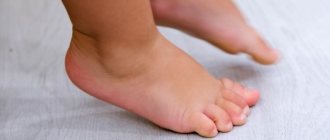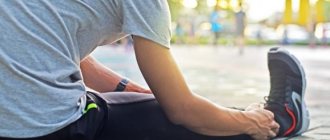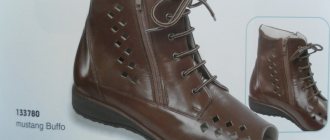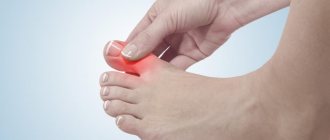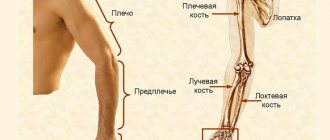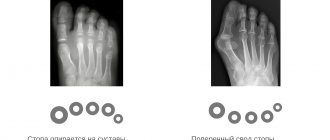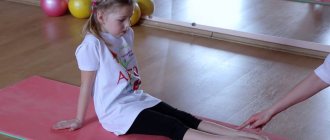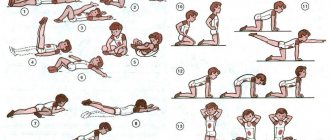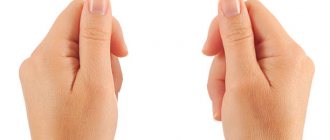When the shape of the foot changes and its arch drops, one of the first measures taken to counteract the deterioration of the condition is the selection and purchase of the correct orthopedic shoes.
Depending on the degree of flat feet, shoes will differ slightly, but the main function that the right shoes should perform for flat feet in adults is good fixation and proper distribution of the load when walking.
Possible complications
Wearing uncomfortable shoes that don't fit properly contributes to the development of flat feet. Particularly noteworthy are high-heeled shoes, which lead to foot deformation in women.
You should understand the importance of choosing the right shoes, since an advanced disease can bring many unpleasant surprises over time.
Complications that can occur with flat feet include: pain in the legs, knees, hip joints; heavy gait or club feet; incorrect posture; pain when bending and squatting; improper development of leg muscles; Possible deformities of fingers and toenails.
How orthopedic and therapeutic shoes will help cope with flat feet
Therapeutic orthopedic shoes can cope with defects in the development of the foot until the child reaches the age of twelve. By this time, the foot has completed its formation, and later flat feet cannot be completely eliminated.
The most important details of orthopedic shoes - a high top, a hard heel, a specially designed sole and heel - fix the child’s foot in an anatomically correct position, which allows the foot to develop without deformation
Therapeutic shoes are not worn on their own - they serve as a frame for an orthopedic insole, which is selected based on the diagnosis. The insole forms the correct arch of the foot and corrects postural disorders.
Stages of foot deformation
The development of flat feet occurs in several stages. To determine the degree of flatfoot, you should consult an orthopedist, because the first stage is noticeable only to specialists.
At the second stage, the deformity can already be detected with the naked eye and pain may appear when walking.
Types of orthopedic insoles for flat feet in adults
Orthopedic insoles can be with a shell frame (framework) or soft (frameless). Soft insoles are recommended for purely preventive purposes when there are no foot problems yet. At the first signs of developing flat feet, you need to choose frame insoles. The most correct approach is to buy insoles along with your shoes. From experience, a long insole takes up half a shoe size. In this case, you need to take into account the fullness of the shoes. If the shoes are incomplete, and even narrow, then after inserting the insole there will be little space in the shoe and the foot will be uncomfortable. As an option, you can buy orthopedic half-insoles. In this case, the toe part remains free and such an insole takes up less space.
Orthopedic insoles and arch supports can be made from different materials. The most common are the classic versions made of genuine leather. These insoles absorb moisture well, neutralize unpleasant odors, and relieve burning feet. It is important to pay attention to the fact that the leather is vegetable tanned and does not contain pentachlorophenol. Vegetable tanned leather does not cause allergies or skin irritations.
For winter, insoles are available with an insulating layer, usually with aluminum foil. The top in this case can be made of wool, felt or multifunctional fiber. The latter is also recommended for shoes with TEX membranes.
In addition to classic leather insoles, insoles coated with high-tech materials and fibers are also widely used. Many of them contain activated carbon, which neutralizes odors.
The new generation of orthopedic insoles are shape memory insoles made of polyurethane foam. These insoles adapt to the individual shape of the foot and relieve pressure and impact on the foot.
How to care for orthopedic insoles
Insoles for flat feet require special care to extend their service life. Insoles can be damaged due to excessive physical activity, heavy body weight, intensity and regularity of wear. The top layer of insoles wears out and becomes dirty over time. The frame base does not change the functionality. When caring for a product, it is important to maintain its integrity and corrective properties.
The skin can be wiped with a weak alcohol solution. Other materials can be cleaned from contamination with a soap solution. Washing in a washing machine and using aggressive detergents is strictly prohibited.
Currently, special products are offered for cleaning insoles made of any materials, for example, IN & OUT cleaner from the German brand NATCH.
Those who have chosen the right insoles have already experienced their positive effects. The products relieve foot deformities, subsequent leg diseases and problems with the musculoskeletal system.
What should be your everyday shoes?
For stages I and II, shoes must have a solid heel that will properly fix the heel. The heel should be small, up to 4 cm, but not less than two.
- Options for modern renovations in a room
Weights for arms and legs - tips and recommendations for choosing weights and selecting optimal exercises (130 photos)
How to choose knee bandages: tips, reviews, correct bandaging and bandage application (145 photos and videos)
If the first stage of flat feet quickly progressed to the second, then you should abandon simple shoes altogether. Doctors advise wearing lace-up styles with wide round toes and instep supports at stages 1-2 and additionally using orthopedic pads for the fingers.
The insole inside the shoe must be made of natural material such as leather, suede or nubuck. Since these materials are natural, the air exchange process occurs well. The foot sweats less and, as a result, this prevents the formation of chafing and calluses.
What shoes to choose for different seasons
- In summer, it is undesirable to wear patent leather shoes, as they do not allow air and moisture to pass through well. It is suitable for a one-time exit, but not for every day. For constant wear, choose shoes made from natural materials or open sandals.
- Shoes for autumn and spring should not allow water to pass through and at the same time should “breathe”. If there is a zipper on demi-season shoes or boots, it should not start at the very sole, but a little higher, otherwise moisture will get inside even when stepping on a shallow puddle. Autumn and spring shoes should also not fit tightly to the foot, since they must be put on over the toe.
- For winter shoes, the main thing is the sole, which is thick enough, with a tread that prevents slipping. The best option for icy conditions is boots with different tread patterns, for example a combination of stripes with rounded protrusions. The protector should also be present on the heel, always rubber and not plastic, so that the foot does not slip.
The optimal winter shoes are leather, lined with natural fur and have a fur insole.
Sports shoes
Sports shoes for flat feet should perform the function of properly redistributing the load and reducing stress as much as possible. The toes in such shoes should be free, and the heel should be firmly fixed.
It is better to choose models with laces or Velcro so that you can fix the boot to the individual size of your foot.
Choosing the right orthopedic insoles for flat feet
In orthopedic salons, pharmacies, kiosks at clinics, as well as in stores selling comfortable shoes, you can find preventive and sports insoles for sale. They perform different functions. The first option is suitable for restoring the natural position of the feet, and the second for the prevention of leg diseases.
Sports insoles are used by athletes to improve spring and support function, increase endurance and reduce the possibility of injury. The product helps to distribute loads evenly and stabilize the ankle joint during exercise.
Individual therapeutic insoles are prescribed by a doctor and selected separately for each patient, since the feet have their own anatomical features. Orthopedists take an impression and make individual insoles.
For minor foot deformities and flat feet at the initial stage, it is enough to purchase preventive insoles. Such insoles are distinguished by the presence of special pads to support the arches of the foot, heel pads, as well as the so-called metatarsal roller - a convex pad located in the midfoot.
Women's shoes
With flat feet, women are advised to avoid wearing high-heeled or platform shoes, as they cause further development of flat feet and a rapid transition from the first stage to the third. Sandals and flip-flops are also not recommended.
Shoes for flat feet for women are selected according to the following parameters:
- When purchasing, you should take into account the height of the heel; it should be no more than five centimeters.
- You should not purchase models with tapered toes, as this harms normal blood circulation.
- The width of the shoes should be medium and there should be no seams inside
- The sole should not be hard or flat.
Types of pathology
There are congenital (extremely rare) and acquired flat feet.
According to another classification, flat feet can be:
- longitudinal – the longitudinal arch is flattened, as a result of which the foot lengthens;
- transverse – the transverse arch is smoothed out, causing the foot to become wider;
- combined, or longitudinal-transverse - both arches are violated.
Depending on the cause of the pathological changes, flatfoot is classified into static (observed in 82% of cases), rachitic, paralytic, and traumatic.
Choosing children's orthopedic shoes
The selection of shoes for children with flat feet should be approached very carefully. If a child has flat feet, the choice of shoes is not made based on appearance. Children's flat feet can be cured with the right type of shoes and foot massage.
When choosing shoes, you should consult with a specialized doctor, as he can adjust models at different stages of the development of the disease. Children's shoes should have a heel of up to two centimeters, the sole should not be completely flat and hard.
Shoes should have a rigid back, laces and Velcro are preferable to zippers. And most importantly, children's shoes should be made from natural hypoallergenic materials; they should allow the child's feet to breathe.
Having answered the question of what kind of shoes are needed for flat feet, it is worth noting first of all that they should be comfortable, and the person wearing such shoes should feel comfortable.
Shoes should provide comfort, be true to size, shoes should be spacious, have special insoles, toes should not be narrow, fasteners or laces should not press. Such shoes are not much different in appearance from ordinary ones, but their cost is several times higher.Children's shoes for the prevention of flat feet
Prevention is easier than treatment - this principle should be followed by parents who want to protect their child from a disease that can be considered one of the most common ailments of modern people.
To avoid problems with the musculoskeletal system, it is important to buy the right children's shoes when the baby is just learning to walk. To begin with, you should get slippers made of soft, breathable material that can be adjusted to your feet (with buckles, Velcro, laces). The sole should bend well.
The maximum height of the heel in childhood should not exceed 1.5-2 cm. This element should be wide, stable, and occupy at least a third of the area of the sole. Buying boots with a wide toe box will prevent deformation of the toes and the appearance of painful calluses. The foot in the shoe should not dangle, moving sideways or backwards.
Photo tips on what shoes to wear if you have flat feet
Exercise bike for home - review of the best models and manufacturers. Tips for choosing and nuances of effective training (145 photos and videos)The best wrist expander - tips for choosing for training, review of models, benefits and harms of the exercise machine (115 photos)
Corset for back posture: the best models, reviews and recommendations for choosing models for athletes (130 photos)
Shoes that are too narrow
Narrow shoes squeeze your feet. The forefoot cannot be positioned freely. The thumb and little finger are pressed inward, and the middle fingers are bent. An unnatural position, first of all, provokes the appearance of calluses.
Also, pinched toes do not participate in the smooth roll of the foot from heel to toe. The gait ceases to be easy and the joints suffer - the shock load when walking with pinched fingers is distributed unevenly.
Due to tight shoes, normal blood flow is disrupted. There are prerequisites for numbness, cramps, premature leg fatigue and swelling at the end of the day.
Therefore, shoes that closely follow the natural contours of the foot are preferred.
